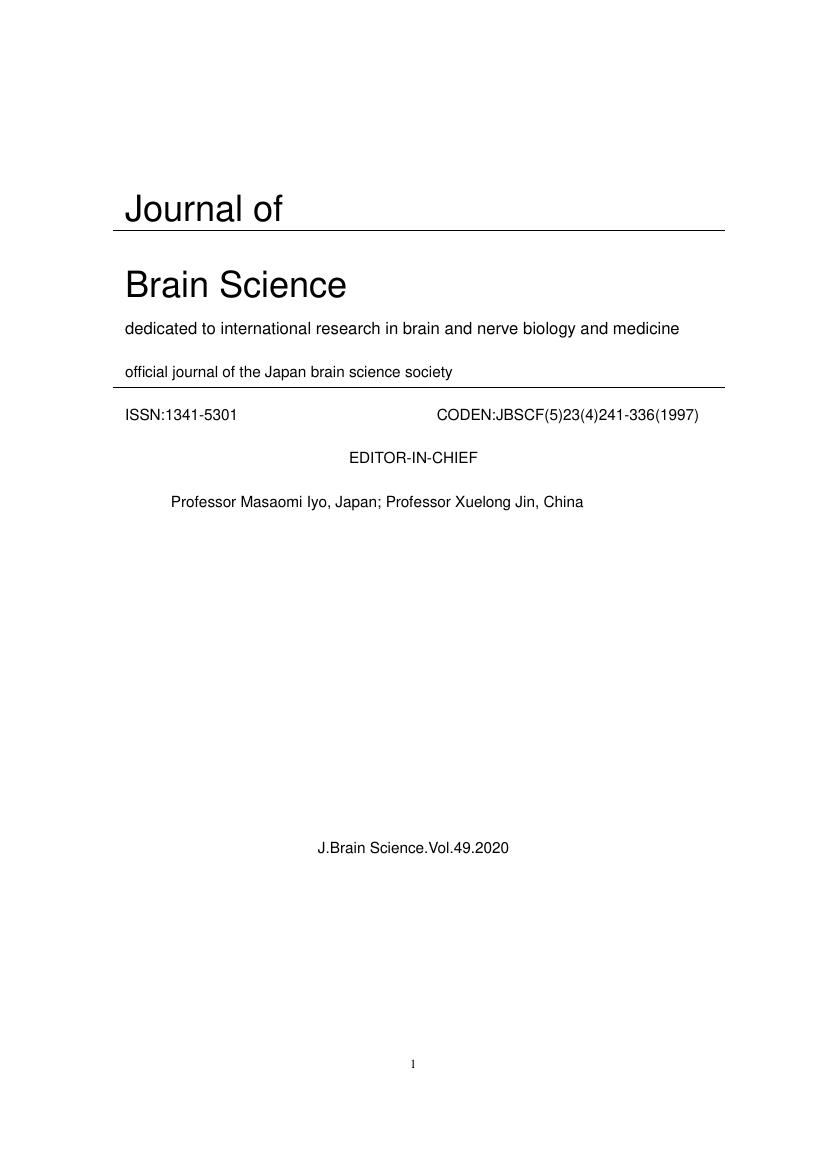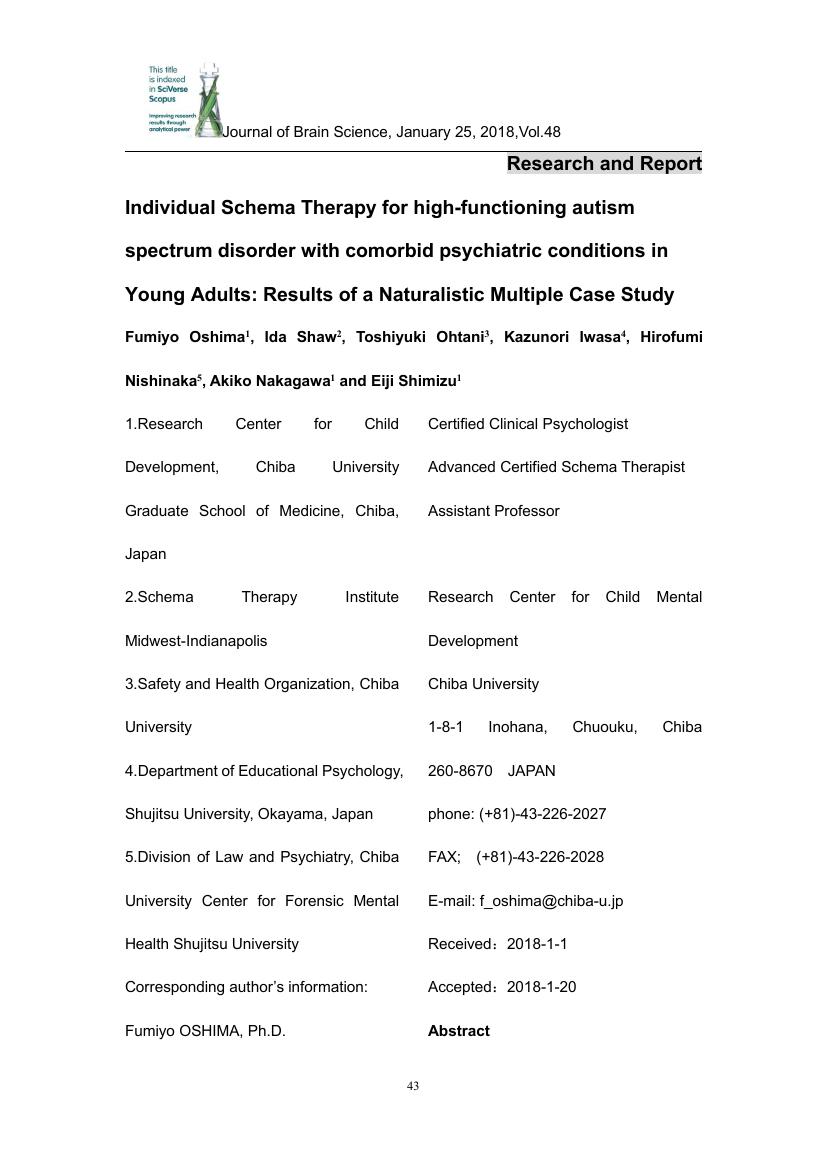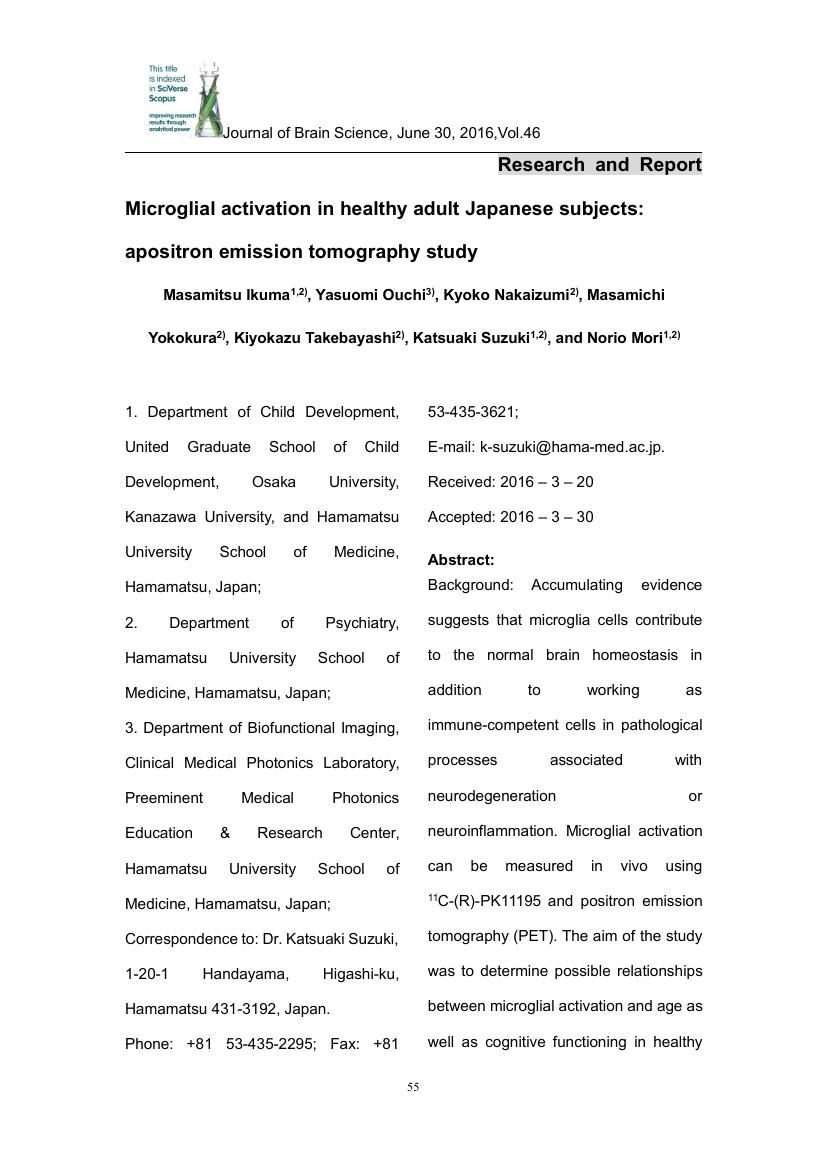- 著者
- Yoko Sagawa Tomoko Nishimura Yoko Nomura Toshiki Iwabuchi Taeko Harada Akemi Okumura Chikako Nakayasu Nagahide Takahashi Nori Takei Kenji J. Tsuchiya
- 出版者
- Japan Brain Science society
- 雑誌
- 脳科学誌 (ISSN:13415301)
- 巻号頁・発行日
- vol.49, pp.32-62, 2020 (Released:2020-12-01)
- 参考文献数
- 40
- 著者
- Shigeyuki Yamamoto Taiichi Katayama Kohji Sato
- 出版者
- Japan Brain Science society
- 雑誌
- 脳科学誌 (ISSN:13415301)
- 巻号頁・発行日
- vol.50, pp.5-30, 2021 (Released:2022-01-13)
- 参考文献数
- 39
- 著者
- Akiko Kuribayashi-Yuge Yoko Kato Isao Ueda Hiroshi Nittono Masako Taniike Ikuko Mohri
- 出版者
- Japan Brain Science society
- 雑誌
- 脳科学誌 (ISSN:13415301)
- 巻号頁・発行日
- vol.50, pp.31-62, 2021 (Released:2022-01-13)
- 参考文献数
- 42
1 0 0 0 OA Investigation of the reliability and validity of the Japanese Deliberate Self-Harm Inventory
- 著者
- Taiko Ohira Toshio Munesue Manabu Oi Kunitake Suzuki Daisuke Saito
- 出版者
- Japan Brain Science society
- 雑誌
- 脳科学誌 (ISSN:13415301)
- 巻号頁・発行日
- vol.48, pp.14-42, 2018 (Released:2018-04-16)
- 参考文献数
- 23
- 著者
- Chiori Kamiya Kuriko Kagitani-Shimono Yoshiko Iwatani Masaya Tachibana Ikuko Mohri Masako Taniike
- 出版者
- Japan Brain Science society
- 雑誌
- 脳科学誌 (ISSN:13415301)
- 巻号頁・発行日
- vol.50, pp.63-100, 2021 (Released:2022-01-13)
- 参考文献数
- 60
- 著者
- Fumiyo Oshima Ida Shaw Toshiyuki Ohtani Kazunori Iwasa Hirofumi Nishinaka Akiko Nakagawa and Eiji Shimizu
- 出版者
- Japan Brain Science society
- 雑誌
- 脳科学誌 (ISSN:13415301)
- 巻号頁・発行日
- vol.48, pp.43-69, 2018 (Released:2018-04-16)
- 参考文献数
- 31
- 著者
- 石井 進
- 出版者
- 公益財団法人 史学会
- 雑誌
- 史学雑誌 (ISSN:00182478)
- 巻号頁・発行日
- vol.94, no.2, pp.246-248, 1985-02-20 (Released:2017-11-29)
1 0 0 0 OA Microglial activation in healthy adult Japanese subjects: apositron emission tomography study
- 著者
- Masamitsu Ikuma Yasuomi Ouchi Kyoko Nakaizumi Masamichi Yokokura Kiyokazu Takebayashi Katsuaki Suzuki Norio Mori
- 出版者
- Japan Brain Science society
- 雑誌
- 脳科学誌 (ISSN:13415301)
- 巻号頁・発行日
- vol.46, pp.55-69, 2016 (Released:2017-05-09)
- 参考文献数
- 38
- 著者
- Gandhervin Kesavamoorthy Sumiko Mikawa Yuya Kusakawa Tomonori Sato Michihito Miyagi Satoru Yamagishi Kohji Sato
- 出版者
- Japan Brain Science society
- 雑誌
- 脳科学誌 (ISSN:13415301)
- 巻号頁・発行日
- vol.46, pp.70-83, 2016 (Released:2017-05-09)
- 参考文献数
- 21
1 0 0 0 OA Bone Morphogenetic Protein Receptor IA and IB expression in the adult rat trigeminal nuclei
- 著者
- Yutaro Hayashi Sumiko Mikawa Kazuma Masumoto Fuminori Katou Kohji Sato
- 出版者
- Japan Brain Science society
- 雑誌
- 脳科学誌 (ISSN:13415301)
- 巻号頁・発行日
- vol.47, pp.5-20, 2017 (Released:2017-11-01)
- 参考文献数
- 18
- 著者
- Sakiko Koshimura Toshio Munesue Hiroyuki Nakamura Manabu Oi
- 出版者
- Japan Brain Science society
- 雑誌
- 脳科学誌 (ISSN:13415301)
- 巻号頁・発行日
- vol.47, pp.50-68, 2017 (Released:2017-11-01)
- 参考文献数
- 12
1 0 0 0 OA Influence of unbalanced large head on neurodevelopment in infancy: a longitudinal birth cohort study
- 著者
- Ryuichiro Oshima Kenji J. Tsuchiya Norio Mori Nori Takei
- 出版者
- Japan Brain Science society
- 雑誌
- 脳科学誌 (ISSN:13415301)
- 巻号頁・発行日
- vol.46, pp.34-54, 2016 (Released:2017-05-09)
- 参考文献数
- 35
- 著者
- Kohji Sato
- 出版者
- Japan Brain Science society
- 雑誌
- 脳科学誌 (ISSN:13415301)
- 巻号頁・発行日
- vol.46, pp.20-33, 2016 (Released:2017-05-09)
- 参考文献数
- 27
- 著者
- Jinlong Cheng Bolin Chen
- 出版者
- Japan Brain Science society
- 雑誌
- 脳科学誌 (ISSN:13415301)
- 巻号頁・発行日
- vol.45, pp.45-56, 2015-03-30 (Released:2017-06-01)
Cerebrovascular disease is a kind of complications in diabetes mellitus which is induced by suger, fat and protein metabolic disorder. These series of nutrient metabolic disorder can lead to intracranial large blood vessels and microvascular lesions. About 20-40 percent of type 2 diabetes patients will suffer from cerebrovascular diseases which become the main causes of death in diabetic patients. Recently many kinds of pathogenesis have been found by researchers about cerebrovascular diseases in diabetes mellitus such as hyperglycemia, insulin resistance, endothelial cell dysfunction, abnormal lipids metabolism and so on. The major clinical manifestations of diabetic cerebrovascular diseases are asymptomatic cerebral atherosclerosis, stroke, cerebral small vessel diseases and acute cerebral vascular diseases. This article will introduce the pathogenesis and clinical features of diabetic cerebrovascular diseases in detail. We will also focus on its latest research progress.
- 著者
- Cong Li Xiang-lin Chi
- 出版者
- Japan Brain Science society
- 雑誌
- 脳科学誌 (ISSN:13415301)
- 巻号頁・発行日
- vol.44, pp.24-33, 2014-12-30 (Released:2017-06-01)
- 著者
- Yandong Wang Yan Wu Xuelong Jin
- 出版者
- Japan Brain Science society
- 雑誌
- 脳科学誌 (ISSN:13415301)
- 巻号頁・発行日
- vol.45, pp.35-44, 2015-03-30 (Released:2017-06-01)
China is a populous country, it is well known that there are many people who need treatment. The majority of patients are looking forward to big hospitals of urban to accept treatments. As the number of patients is increasing, the load of medical workers is more and more heavy. It is hard-won for medical workers to have a long holiday, because it will take a huge burden to colleagues. So to alleviate the mental stress has become a urgent affair instead of a long holiday. The Morita therapy is a kind of behavioral treatment which comes from Japan. It is valuable to consider whether this kind of treatment is useful for medical workers. We begin our research towards the direction of alleviating the mental stress of the hospital staff. As the core of the Morita therapy, it is important to understand the meaning of leting nature taking its course. It is impossible to alleviate the tension and reduce the incidence rate of obsessive compulsive disorder even if doing a lot of works. We advance our research based on this opinion. The fear in the obsessive concept is a difficulty in the Morita therapy. We want to provide a relaxing circumstance for patients to help them relax themselves. Thus we consider that it is impossible to help them relax by the use of music. Not all the music is available for one person. People have found that the treatment effect is related to the frequency of music. For example: some people hold the idea that listening to high frequency music does not have a good effect on people who are deeply mired in depression. However, letting them listen to the appropriate music has the effect of adjusting heart.
- 著者
- Yuki Miyatake Shinsuke Matsuzaki Manabu Taniguchi Hironori Takamura Kohei Yamada Tsuyoshi Hattori Toshiki Kameyama Takayuki Manabe Masaya Tohyama Taiichi Katayama
- 出版者
- Japan Brain Science society
- 雑誌
- 脳科学誌 (ISSN:13415301)
- 巻号頁・発行日
- vol.45, pp.5-34, 2015-03-30 (Released:2017-06-01)
Alternative splicing (AS) contributes to the generation of distinct mRNAs from the same pre-mRNA. This mechanism is highly conserved in eukaryotes and yields proteomic diversity. Furthermore, AS can be tissue- and developmental stage-specific and is an important process in the development of the central nervous system. Although these features suggest that AS variants contribute the complexity of the brain, the characteristics of most AS variants are unclear. Therefore, it is important to identify and examine novel AS variants in neuronal tissues to fully understand neuronal functions. We have identified a novel AS variant of murine disrupted in schizophrenia 1 (Disc1), a neural developmental gene. This variant lacks exon 2 and is named 'ΔE2'. We also show differences in the expression levels and localization patterns between ΔE2 and full length Disc1 (FL) in the murine brain. Differences in the subcellular localization patterns of both isoforms in cultured SK-N-SH cells suggest that ΔE2 has different functions compared with those of FL. Further functional analysis of ΔE2 may indicate additional roles of Disc1, and may further our understanding of the developmental mechanisms for neurodevelopmental disorders such as schizophrenia.
- 著者
- Qiaoyan Liu Xuelong Jin
- 出版者
- Japan Brain Science society
- 雑誌
- 脳科学誌 (ISSN:13415301)
- 巻号頁・発行日
- vol.44, pp.42-62, 2014-12-30 (Released:2017-06-01)
Radiation therapy, the most commonly used for the treatment of brain tumors, has been shown to be of major significance in tumor control and survival rate of brain tumor patients. About 200,000 patients with brain tumor are treated with either partial large field or whole brain radiation every year in China. The use of radiation therapy for treatment of brain tumors, however, may lead to devastating functional deficits in brain several months to years after treatment. An initial brain pathology resulting from exposure to radiation appears to be the dysfunction or disruption of the blood-brain barrier (BBB) and edema formation, which resulted from loss of tight junction (TJ) proteins and BBB components pericytes and astrocyte end-feet. Both of these scenarios lead to apoptosis of endothelial and neural cells and neuroinflammation in and around capillaries, which may progress into a variety of neurological impairments. It's been found that Bone-marrow-derived EPCs (endothelial progenitor cells) play an integral role in the regulation and protection of the endothelium, as well as new vessel formation. It can incorporate into injured vessels and become mature endothelial cells during re-endothelialization and neovascularization processes, so the transplantation of EPCs into ischemic tissues provide a novel therapeutic option for radiation-induced brain injury. The efficacy of EPCs repairing disrupted BBB can be evaluated from the changes of expression of S100B, VEGF and EBA. MRI is a non-invasive method that can be used to track labeled transplanted cells,which can show the exact trace of EPCs in the region of brain injury. This review discusses the therapeutic potential of EPCs for vascular ischemic diseases associated with radiation-induced brain injury.
- 著者
- Yukiko Ishibashi Nobuo Izumo Keiko Iwata Tomomi Morikawa Toshiki Kameyama Yasuo Watanabe Takayuki Manabe Hideo Matsuzaki
- 出版者
- Japan Brain Science society
- 雑誌
- 脳科学誌 (ISSN:13415301)
- 巻号頁・発行日
- vol.46, pp.5-19, 2016 (Released:2017-05-09)
- 参考文献数
- 20
- 著者
- Motohide Furuya Tsuyoshi Miyaoka Sadayuki Hashioka Rei Wake Keiko Tsuchie Jun Horiguchi
- 出版者
- Japan Brain Science society
- 雑誌
- 脳科学誌 (ISSN:13415301)
- 巻号頁・発行日
- vol.44, pp.34-41, 2014-12-30 (Released:2017-06-01)
Brain-derived neurotrophic factor (BDNF) is expressed at high levels in the hippocampal dentate gyrus (DG), and decreased levels of BDNF have been implicated in the pathophysiology of schizophrenia (SCZ). We have previously reported that yokukansan (YKS), which is a traditional Japanese medicine, is effective for SCZ and promotes neurogenesis in the DG of Gunn rats, an animal model of SCZ. In this study, we investigated the effect of YKS on serum BDNF levels in Gunn rats. The results showed that YKS increased serum BDNF in this model, which may suggest that BDNF expression in the DG leads to increased neurogenesis. Our findings may help to explain the efficacy of YKS in treating SCZ.














